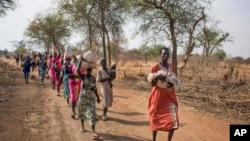The FAO said the highest prevalence of acute hunger, ranging between 65% and 75% of the population, is reported in northern Unity, Upper Nile and Jonglei states, in the Pibor area in the east near the border with Ethiopia, and among South Sudanese returning from war-torn Sudan.
The Rome-based agency expressed special concern about the 79,000 people facing the highest catastrophic levels of food insecurity and starvation. It said 11,000 are in the Pibor area, 40,000 are in Northern Bahr el Ghazal state’s Aweil East County, and 28,000 are South Sudanese who fled the year-long conflict in Sudan and are spread across the country.
FAO said the main drivers of “the dire food security situation” are protracted economic challenges that have sparked high inflation, “insufficient food supplies, the lingering impact of consecutive years with widespread floods and episodes of intercommunal violence.”
The landlocked country is facing an economic crisis due to a decline in oil exports after war-torn Sudan declared force majeure on oil shipments—South Sudan’s main export—passing through the country in March. The fighting in Sudan has affected shipments destined for a terminal near Port Sudan along the Red Sea coast.
The world’s newest nation, which gained independence from Sudan in 2011, has also been struggling to integrate rival military forces, draft a new constitution and prepare for its delayed first elections in December 2024.

Forum